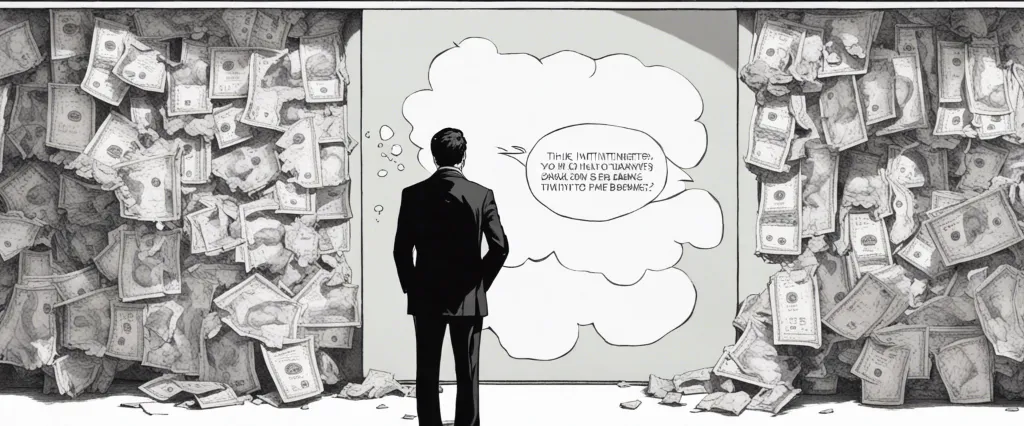
In the vast realm of literature, two distinct works stand out, representing contrasting yet equally captivating tales about influential events in the world of finance. Andrew Ross Sorkin’s Too Big to Fail and John Steele Gordon’s “The Great Game” offer insightful perspectives on crucial moments that shaped the global economic landscape. Although their subject matters diverge, the books share a common thread—a deep exploration of the inner workings of financial systems and the consequences they impose on society. By delving into the intricacies of the 2008 financial crisis and the fascinating history of the American financial markets, Sorkin and Gordon invite readers to embark on an enthralling journey that immerses them in the complexities of power, greed, and the indomitable spirit of survival in an ever-changing financial world. Through their distinct narratives and approaches, these authors shed light on the dynamics of contemporary finance, allowing readers to refine their understanding of its strengths, weaknesses, and the lessons to be learned from history. As we embark on this comparative exploration of “Too Big to Fail” and “The Great Game,” our aim is to unravel the distinctive qualities of each, examining their respective narratives, character development, and underlying themes while ultimately contemplating the broader implications of these two literary works for our understanding of the financial sector.
Brief Summary of Two Books
Too Big to Fail by Andrew Ross Sorkin
Too Big to Fail” by Andrew Ross Sorkin is a non-fiction book that provides an in-depth account of the 2008 financial crisis. The book delves into the events leading up to the crisis, the decisions made by key players at Wall Street and in the government, and the series of events that unfolded during the crisis.
Sorkin takes readers behind the scenes, offering a detailed and comprehensive narrative of the major players involved, including top executives from major financial institutions such as Lehman Brothers, Merrill Lynch, and Goldman Sachs, as well as key government officials like Treasury Secretary Henry Paulson and Federal Reserve Chairman Ben Bernanke.
The author presents a compelling narrative that highlights the interconnectedness of the financial industry and the impact of the crisis on the global economy. Sorkin explains complex financial concepts in an accessible manner, allowing readers to grasp the underlying causes and consequences of the crisis.
“Too Big to Fail” offers an inside look into critical moments of the crisis, such as the collapse of Lehman Brothers, the unprecedented government intervention to save financial institutions, and the subsequent market turmoil. The book reveals the intense pressure faced by regulators and policymakers as they struggled to prevent a complete collapse of the financial system.
Ultimately, the book serves as a cautionary tale about the dangers of an unchecked financial industry and the need for stronger regulation and oversight. It provides readers with a comprehensive understanding of the 2008 financial crisis, one of the most significant events in recent history, and its reverberations across the global economy.
The Great Game by John Steele Gordon
The Great Game” by John Steele Gordon is a non-fiction book that explores the history of Wall Street and the evolution of the American economy. The book takes readers on a journey through the key events and individuals that shaped Wall Street, from its humble beginnings as a small trading street in 17th-century Manhattan to becoming the financial powerhouse it is today.
Gordon delves into the fascinating stories of legendary figures such as Alexander Hamilton, J.P. Morgan, and Warren Buffett, who played crucial roles in the development of Wall Street. He also traces the profound impact of major historical events, such as the Great Depression and the 2008 financial crisis, on the financial landscape.
Through an engaging narrative, Gordon discusses the rise of the New York Stock Exchange and the development of various financial instruments like stocks, bonds, and derivatives. He touches upon the influence of major financial innovations and technological advancements, such as the creation of mutual funds and the rise of electronic trading.
“The Great Game” also sheds light on the inner workings of Wall Street, delving into the world of investment banking, mergers and acquisitions, hedge funds, and investment strategies. Gordon provides insights into the risks and rewards related to different investment activities, giving readers a deeper understanding of the intricacies of the financial world.
Overall, “The Great Game” offers an informative and accessible account of the history and significance of Wall Street, providing readers with a comprehensive overview of the forces that have shaped the American economy over the centuries.
Comparison between Two Books

Similarities in Financial Documentary
Both “Too Big to Fail” by Andrew Ross Sorkin and “The Great Game” by John Steele Gordon shed light on the world of finance and provide an in-depth analysis of the events leading up to and during financial crises.
1. Deep dive into the financial landscape: Both books extensively explore the intricate workings of the financial industry, dissecting complex concepts and explaining the inner workings of various financial institutions. They provide a comprehensive understanding of the factors that contributed to the crises and the subsequent fallout.
2. Focus on crucial events: Both books primarily revolve around a pivotal event in recent financial history. “Too Big to Fail” focuses on the 2008 financial crisis and the collapse of Lehman Brothers, while “The Great Game” delves into the history and consequences of the stock market crash in 1929. Both books highlight the dire repercussions and how they impacted the global financial system.
3. Inclusion of prominent figures: Both books feature accounts of influential figures in the financial world who played significant roles in the crises. These key players, such as Treasury Secretary Henry Paulson in “Too Big to Fail” and stockbrokers such as Richard Whitney in “The Great Game,” are depicted in their decision-making roles and their impact on the financial landscape.
4. Examination of government intervention: Both books explore the role of government intervention during financial crises. They analyze the actions taken by governments to stabilize the economy and prevent further damage. “Too Big to Fail” focuses on the government’s response to the 2008 crisis, while “The Great Game” examines the creation of the Federal Reserve System in response to the 1929 crash.
5. Reflection on systemic issues: Both books reflect on broader systemic issues within the financial sector that contributed to the crises. They discuss the misuse of complex financial instruments, regulatory failures, and excessive risk-taking. The authors dissect these issues to highlight the need for reform and to prevent similar crises from occurring in the future.
In summary, both “Too Big to Fail” and “The Great Game” provide thorough examinations of financial crises, diving deep into the financial landscape, highlighting the key events and figures involved, and reflecting on systemic issues. These books act as financial documentaries, offering insights into the complexities of the financial world and the potential consequences of major financial crises.
Divergences in Financial Documentary
Both Too Big to Fail by Andrew Ross Sorkin and The Great Game by John Steele Gordon are financial documentaries that delve into significant events in the world of finance. However, there are distinct differences between these books in terms of their approach, focus, and intended audience.
In terms of approach, Too Big to Fail takes a journalistic approach with extensive research and interviews to provide an in-depth behind-the-scenes account of the 2008 financial crisis. Sorkin, a financial journalist, brings readers into boardrooms and offices of key players, offering a blow-by-blow narrative. On the other hand, The Great Game takes a more historical approach, providing a broader view of financial crises throughout American history. Gordon, an economic historian, examines different financial events over centuries to trace the recurring patterns and themes.
In terms of focus, Too Big to Fail primarily focuses on the 2008 crisis and the actions taken by the government and financial institutions to prevent a complete collapse. It highlights the interconnectedness of the financial sector and the potential consequences of major banks failing. On the contrary, The Great Game looks at financial crises in a more comprehensive manner, covering various events such as the Panic of 1837, the Great Depression, and the Dotcom Bubble, among others. It aims to provide a broader understanding of the cyclical nature of financial crises and their implications for society.
Regarding the intended audience, Too Big to Fail is targeted at readers interested in a detailed account of the 2008 crisis. Sorkin’s narrative style and insider perspectives make it accessible for both finance professionals and general readers. On the other hand, The Great Game appeals to readers with an interest in economic history and those seeking a more academic perspective on financial events. Gordon’s historical analysis may require a certain level of familiarity with economic concepts and terminology.
In summary, while both Too Big to Fail and The Great Game are financial documentaries, they differ significantly in approach, focus, and intended audience. Too Big to Fail provides an insider account of the 2008 crisis, whereas The Great Game takes a broader historical perspective on financial crises throughout American history. Each book caters to a different audience, appealing to those interested in recent financial events or those seeking a more comprehensive understanding of financial history.

Conclusion
Both “Too Big to Fail” by Andrew Ross Sorkin and “The Great Game” by John Steele Gordon are highly recommended books in their respective genres, but they offer different perspectives and cater to different interests.
“Too Big to Fail” is a non-fiction book that delves into the 2008 financial crisis and the subsequent government interventions to save major banks and financial institutions from collapsing. It offers a detailed account of the behind-the-scenes actions, discussions, and decision-making processes that took place during this critical time. If you are interested in the world of finance, economics, and the inner workings of Wall Street, this book is a worthy choice. It provides valuable insights into the complexities of the banking system and the interconnectedness of global markets.
On the other hand, “The Great Game” is a historical non-fiction book that explores the rivalry and power struggles between the British and Russian empires in Central Asia during the 19th century. It delves into geopolitical maneuverings, espionage, and the quest for influence and control in a region that became the forefront of competing interests. If you have an interest in history, politics, and the dynamics of international relations, this book is a great choice. It sheds light on an often overlooked period and provides a fascinating account of the Great Game that influenced the development of the world we live in today.
Ultimately, the choice between the two books depends on your personal preferences and interests. If you are more inclined towards finance and contemporary events, “Too Big to Fail” will likely be more appealing. However, if you prefer history and geopolitical struggles, “The Great Game” will be a worthy read.



